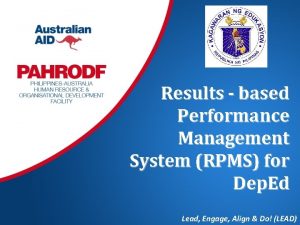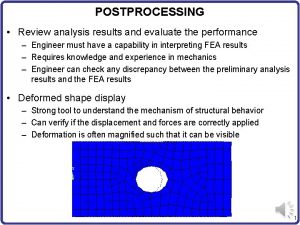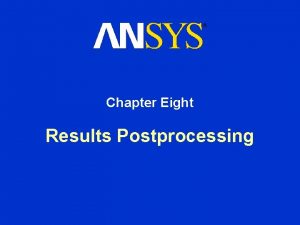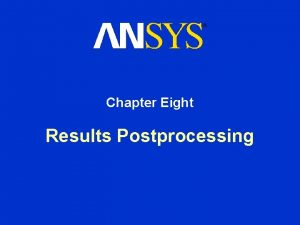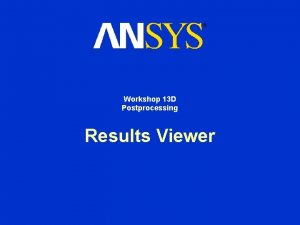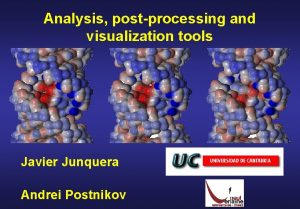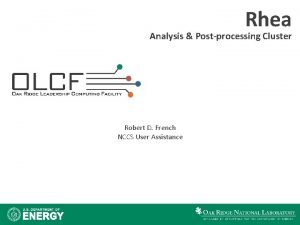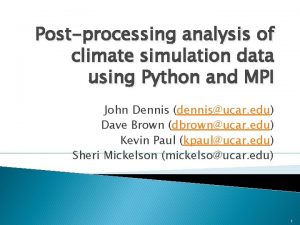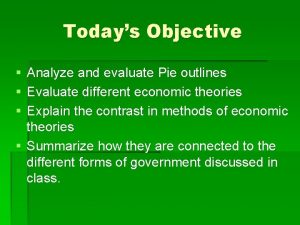POSTPROCESSING Review analysis results and evaluate the performance










- Slides: 10

POSTPROCESSING • Review analysis results and evaluate the performance – Engineer must have a capability in interpreting FEA results – Requires knowledge and experience in mechanics – Engineer can check any discrepancy between the preliminary analysis results and the FEA results • Deformed shape display – Strong tool to understand the mechanism of structural behavior – Can verify if the displacement and forces are correctly applied – Deformation is often magnified such that it can be visible 1

POSTPROCESSING cont. • Contour display – Understand the distribution of the stress in the structure and identify the most critical locations – Max stress 2, 209 psi is 6% higher than that from preliminary analysis results (2, 083 psi) – Accurate stress values at Gauss integration points are extrapolated to nodes – Refined model has 2, 198 psi (. 5% change from the initial model) Size = 0. 2" Size = 0. 1" 2

POSTPROCESSING cont. • Stress averaging – – Contour-plotting algorithms are based on nodal values Stress is discontinuous at nodes Extrapolated stresses are averaged at nodes -> Cause error Difference b/w actual and averaged stress values are often used as criterion of accuracy Stress at integration point Averaged nodal stress Elem 1 Elem 2 Elem 3 3

ESTIMATING ERRORS • Posterior error estimation – – – Check accuracy of current analysis Criterion for mesh refinement Original FE stress s, averaged nodal stress s* Difference in stresses Strain energies – Error estimation – the current mesh size is considered to be appropriate, if h ≈ 0. 05 4

FINITE ELEMENT MODELING TECHNIQUES • Model abstraction – FE model can be different from the physical model – It would be better to gain insight from several simple models than to spend time making a single detailed model – Depending on intention, FE model should have different level of detail – Example of unnecessarily detailed model (purpose: bending/torsional stiffness) 5

MESHING TECHNIQUES • Free meshing vs. mapped meshing – Free meshing: the user provides a general guideline of meshing and the FE software will make the mesh according to it – Mapped meshing: the user provides detailed instructions of how the mesh should be created – In 2 D, all surfaces are divided into topologically four-sided quadrilaterals – The user then specifies how many elements will be generated in each side of the quadrilateral 2 1 -2 -3 1 3 6 4 5 6 4 (a) Physical mesh 5 (b) Topological mesh 6

EXAMPLE OF MAPPED MESH 2 1 5 Fixed BC 3 4 6 7 8 11 9 12 10 2789 N 5066 N 7

MESHING TECHNIQUES cont. • Free meshing vs. mapped meshing – More user action is required in mapped mesh – More complex computer algorithms need to be implemented in free meshing – The mapped mesh looks better because the grid looks more regular, but the quality of elements cannot be assured – Even if the mapped mesh looks more regular, the actual quality should be measured from the level of distortion Mapped mesh Free mesh 8

USING SYMMETRY • Can reduce model size and save computation time • Can provide necessary boundary conditions p p Symmetry plane p p Modeled portion 9

FE MODELING TECHNIQUES cont. • Using symmetry y y x (a) One symmetric plane p p x (b) Two symmetric planes 10

